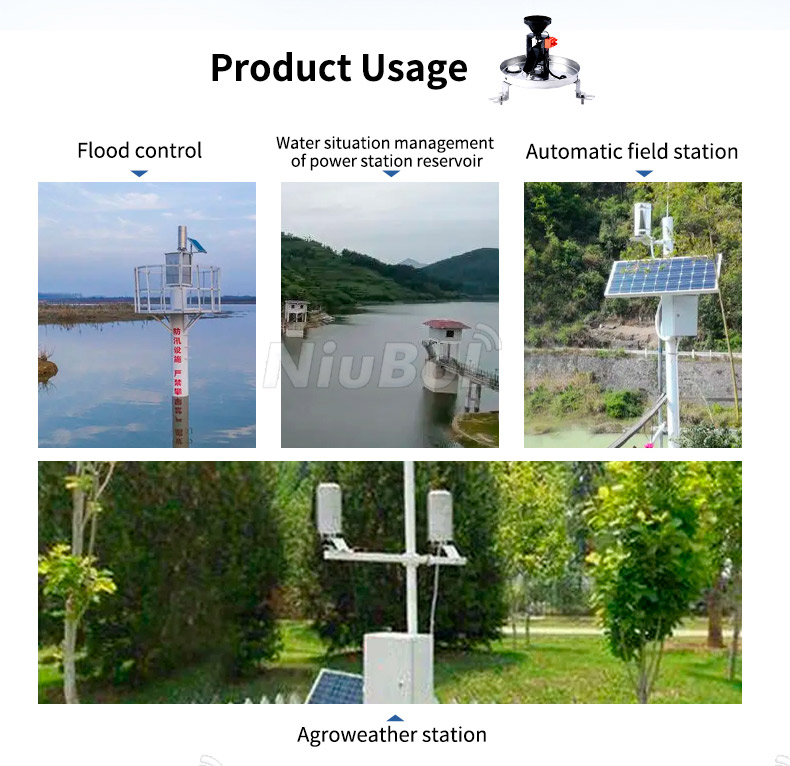

— Blogs —
—Products—
 Consumer hotline +8618073152920
Consumer hotline +8618073152920 WhatsApp:+8615367865107
Address:Room 102, District D, Houhu Industrial Park, Yuelu District, Changsha City, Hunan Province, China
Product knowledge
Time:2024-09-19 21:27:04 Popularity:314
Rain Gauge Sensor, i.e. rainfall sensor, is a device for measuring rainfall. It is widely used in meteorological observation, hydrological monitoring, agricultural irrigation, water resource management and other fields, and is of great significance for flood control, water supply scheduling, and power station and reservoir management.
Rain gauge sensors are electronic devices used to measure precipitation, they can accurately capture the amount of rain or other precipitation, rain sensors can be divided into a variety of types according to the different measurement principles and technical characteristics, the following list of several common types and their approximate price range:
Features: the use of optical principles, through the detection of raindrops (or other precipitation particles such as snow particles) across the sampling space when blocking the light produced by the light signal changes to calculate the amount of rainfall. It has the advantages of high sensitivity, long maintenance-free time, and good adaptability.
Price: The price varies according to brand, model and accuracy requirements, and the general market price ranges from several 100 dollars to several 500 dollars. The specific price should be determined according to the product specifications and purchase channels.
Characteristics: Adopting the tipping bucket structure, through the collection of precipitation, when reaching a certain amount, the container flips over, triggering the electronic counter. This sensor has a simple structure and high reliability, but the accuracy may be affected by the size of the bucket, the counting mechanism and other factors.
Price: Compared to optical rain sensors, tipping bucket rain sensors may be more affordable, with a wider price range from $80 to $300. However, the specific price still needs to be determined according to product specifications and market demand.
Characteristics: Using the piezoelectric effect of piezoelectric materials, the mechanical energy generated by the impact of raindrops is converted into an electrical signal, which in turn measures the amount of rainfall. This sensor has a high sensitivity and fast response speed, but may be affected by ambient temperature, humidity and other factors.
Price: The price of piezoelectric rain sensors varies by brand, model and performance, and is usually in the $200 to $800 price range.
4. Radar Rain Gauges: Measure precipitation through the reflection of radar waves, providing long-range and wide-area precipitation monitoring. Higher price, may exceed $1600, suitable for professional weather stations and complex environmental monitoring.
It should be noted that the above price range is for reference only, and the actual purchase should be based on the specific product, brand, purchase channel as well as market supply and demand to determine the final price.
1. Meteorological observation: rain sensor is one of the necessary equipment for meteorological observation stations, used for real-time monitoring of rainfall, precipitation intensity and other meteorological parameters, for weather forecasting, climate research and other data support.
2. Hydrological monitoring: rainfall sensors are installed at hydrological stations, reservoirs, rivers and other water monitoring points to monitor rainfall and water level changes in real time, providing an important basis for flood control, drought relief, water resource management.
3. Agricultural irrigation: installing rainfall sensors in farmland irrigation systems can adjust the irrigation plan in real time according to the rainfall, avoiding the waste of water resources and improving irrigation efficiency.
4. Urban drainage: installing rainfall sensors in urban drainage systems can monitor rainfall in real time and provide data support for urban drainage scheduling and flood control decisions.
5. Transportation and safety: in highways, railroads and other critical infrastructure for early warning of traffic risks caused by heavy rain.

Summary
Rain Gauge Sensor is an important meteorological observation and hydrological monitoring equipment with a wide range of application scenarios. Depending on the measurement principle and technical characteristics, rain sensors can be categorized into various types, including optical rain sensors, tipping bucket rain sensors, and piezoelectric rain sensors. These sensors differ in price, but all of them can provide accurate and reliable data support for monitoring and management in related fields. When choosing a rain sensor, comprehensive consideration needs to be made based on factors such as actual needs, measurement accuracy and budget.
NBL-W-ARS-Tipping-bucket-rain-gauge-instruction-manual.pdf
NBL-W-RS-Rain-sensors-instruction-manual-V4.0.pdf
NBL-W-PRS-Piezoelectric-Rain-Sensor-Operator's-Manual.pdf
NBL-W-DRS-Double-Tipping-Bucket-Rain-Sensor-Instruction-Manual.pdf
Related recommendations
Sensors & Weather Stations Catalog
Agriculture Sensors and Weather Stations Catalog-NiuBoL.pdf
Weather Stations Catalog-NiuBoL.pdf
Related products
 Combined air temperature and relative humidity sensor
Combined air temperature and relative humidity sensor Soil Moisture Temperature sensor for irrigation
Soil Moisture Temperature sensor for irrigation Soil pH sensor RS485 soil Testing instrument soil ph meter for agriculture
Soil pH sensor RS485 soil Testing instrument soil ph meter for agriculture Wind Speed sensor Output Modbus/RS485/Analog/0-5V/4-20mA
Wind Speed sensor Output Modbus/RS485/Analog/0-5V/4-20mA Tipping bucket rain gauge for weather monitoring auto rainfall sensor RS485/Outdoor/stainless steel
Tipping bucket rain gauge for weather monitoring auto rainfall sensor RS485/Outdoor/stainless steel Pyranometer Solar Radiation Sensor 4-20mA/RS485
Pyranometer Solar Radiation Sensor 4-20mA/RS485
Screenshot, WhatsApp to identify the QR code
WhatsApp number:+8615367865107
(Click on WhatsApp to copy and add friends)